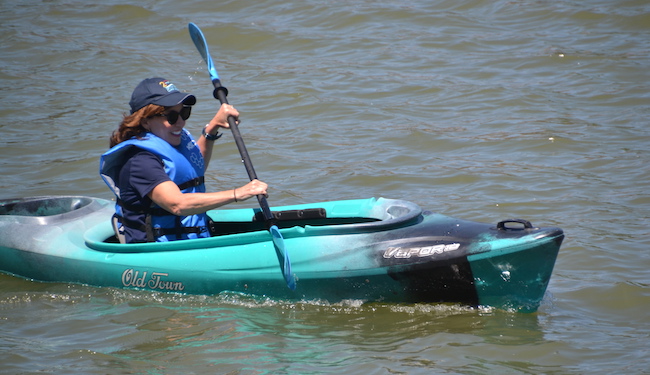Hochul announces Erie Canal Bicentennial Commission planning many events in 2025
State wants to celebrate canal’s 200th anniversary in a big way throughout next year

File photo by Tom Rivers: Kathy Hochul, shown on June 15, 2021 when she was the lieutenant governor, rows in a kayak in the Erie Canal in Medina. She was helping to promote the “On the Canals” program that offered free rental of kayaks and hydro-bikes.
Press Release, Gov. Kathy Hochul’s Office
Governor Kathy Hochul on Friday announced the creation of the Erie Canal Bicentennial Commission to commemorate the 200th anniversary of the completion of the original Erie Canal.
Initially introduced as part of the Governor’s State of the State Address in January, this new commission will ensure that the Erie Canal Bicentennial is recognized through community events, capital investments in canal infrastructure, and by telling the diverse stories that comprise the state’s relationship with this historic waterway. These tangible endeavors to be undertaken throughout 2024 and 2025 will set the tone and stage for the next century of operations and opportunities along the iconic New York State Canal system.
“The Erie Canal is an integral part of New York’s story, and as we commemorate the bicentennial of this important waterway, we will honor the Canal’s history while looking ahead to its vibrant future,” Governor Hochul said. “As a lifelong New Yorker and avid boater from Buffalo who has traveled the Canal, I understand the significance of this waterway on our State’s history, and what it means not only for the identity of so many upstate communities, but also their economic livelihoods.”
The celebration will culminate with the 2025 World Canals Conference in Buffalo, September 21-25, and the departure of the Seneca Chief, Buffalo Maritime Center’s replica vessel that will reenact Governor Dewitt Clinton’s 1825 inaugural cross-state journey along the Erie Canal to New York Harbor.
Leading up to the culminating events in Buffalo in 2025, the commission will support community events, capital investments in canal infrastructure, and the telling of diverse stories in recognition of the celebration’s theme, “Raising More Voices.” Some of these activities include:
- Community Events: Numerous events across Upstate New York funded by the New York State Canal Corporation and the Erie Canalway National Heritage Corridor grant program.
- Arts and Culture: Partnerships with New York State orchestras featuring emerging and diverse composers and offering canalside concerts and educational programing.
- Academic Forums: In partnership with the State University of New York and the Department of State, the SUNY / Erie Canal Bicentennial Forum Series will include a schedule of public lectures and panel discussions covering a range of topics and hosted at SUNY campuses. These sessions will explore how the Canal system can be revitalized and maximized as a driver of upstate economic development and environmental stewardship.
- Bicentennial Promotion Toolkit: Supported by funding from the Erie Canalway National Heritage Corridor and I LOVE NY, communities across the Canal can host local celebrations and promote consistent messaging, social media images and video, fact sheets, display banners and giveaways to build excitement and momentum toward September 2025.
- Legacy Projects: Ribbon cuttings for major community waterfront enhancements and new investments in preservation projects and recreational trails and amenities.
- Economic Development: Investment announcements from the New York Power Authority and Canal Corporation to ensure the Canal remains an economic driver for upstate communities as it enters its third century of operation.
These events will highlight the vital role of the Canal system as a historic example of New York’s spirit of ingenuity and its contemporary role as a driver of upstate economies and as a public recreational asset.
To be co-chaired on a volunteer basis by First Gentleman of New York William J. Hochul Jr., and New York State Canal Corporation Director Brian U. Stratton, the commission will be responsible for the planning, scheduling, and execution of a series of public meetings and commemorative events throughout 2024 and 2025.
The commission co-chairs will be joined by honorary commission members including New York State Secretary of State Walter T. Mosley; Hope Knight, President, CEO and Commissioner of Empire State Development; and Randy Simons, Commissioner Pro Tem of the Office of Parks, Recreation, and Historic Preservation to set the stage for the next century of operations and opportunities along the 524-mile New York State Canal system.
First Gentleman and Erie Canal Bicentennial Commission Co-Chair William J. Hochul Jr. said, “As we near the 200-year mark of the Canal’s operation, I cannot think of a better group to lead our efforts in uplifting the diverse voices that make up the shared history of our canal. Growing up in Buffalo, I saw first-hand the significance of the canal to my community – not just for boating and recreation, but also as a steadfast driver of tourism and economic growth. I am proud to co-chair this commission alongside some of the brightest minds in our state, and I look forward to all the events and discussions to come.”
Canal Corporation Director and Erie Canal Bicentennial Commission Co-Chair Brian U. Stratton said, “On the eve of the Erie Canal’s 200-year anniversary milestone, we are excited to be working with Governor Hochul, the First Gentleman, and our stakeholders and agency partners to establish the Erie Canal Bicentennial Commission. The Erie Canal holds a special significance in New York’s history, and we will engage in a robust two-year plan to mark this anniversary and celebrate the next century of operations and opportunities along the entire Canal System to ensure a vibrant and more inclusive future. The Bicentennial Commission will acknowledge the historic waterway and its ongoing impact on upstate communities through community events, capital investments in canal infrastructure, and the storytelling of diverse narratives that tell New York’s and the nation’s profound relationship with this historic waterway.”
To stay informed of Erie Canal Bicentennial Commission activities and events, please visit www.canals.ny.gov.





































































